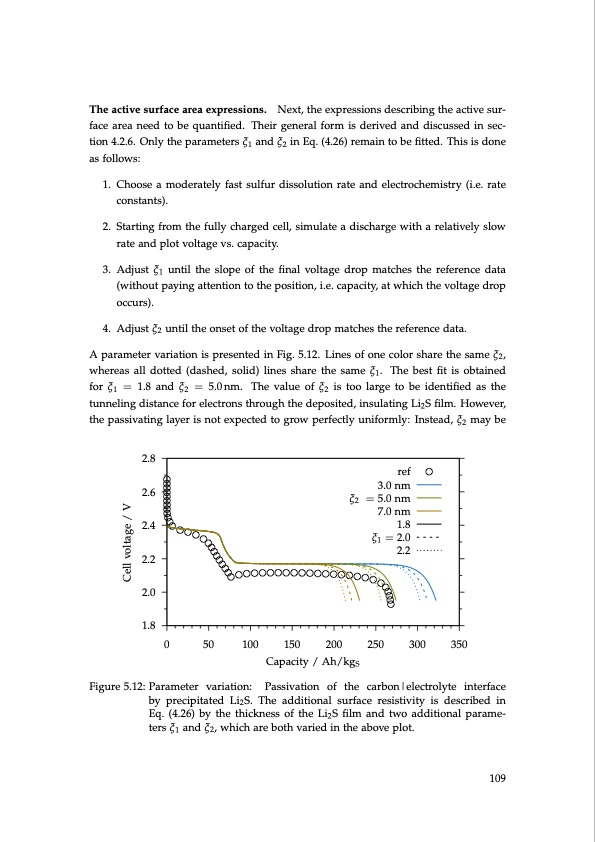
PDF Publication Title:
Text from PDF Page: 109
The active surface area expressions. Next, the expressions describing the active sur- face area need to be quantified. Their general form is derived and discussed in sec- tion 4.2.6. Only the parameters ξ1 and ξ2 in Eq. (4.26) remain to be fitted. This is done as follows: 1. Choose a moderately fast sulfur dissolution rate and electrochemistry (i.e. rate constants). 2. Starting from the fully charged cell, simulate a discharge with a relatively slow rate and plot voltage vs. capacity. 3. Adjust ξ1 until the slope of the final voltage drop matches the reference data (without paying attention to the position, i.e. capacity, at which the voltage drop occurs). 4. Adjust ξ2 until the onset of the voltage drop matches the reference data. A parameter variation is presented in Fig. 5.12. Lines of one color share the same ξ2, whereas all dotted (dashed, solid) lines share the same ξ1. The best fit is obtained for ξ1 = 1.8 and ξ2 = 5.0nm. The value of ξ2 is too large to be identified as the tunneling distance for electrons through the deposited, insulating Li2S film. However, the passivating layer is not expected to grow perfectly uniformly: Instead, ξ2 may be 2.8 2.6 2.4 2.2 2.0 1.8 Figure 5.12: Parameter variation: Passivation of the carbon|electrolyte interface by precipitated Li2S. The additional surface resistivity is described in Eq. (4.26) by the thickness of the Li2S film and two additional parame- ters ξ1 and ξ2, which are both varied in the above plot. ref 3.0 nm ξ2 = 5.0 nm 7.0 nm 1.8 ξ1 = 2.0 2.2 0 50 100 150 200 250 300 350 Capacity / Ah/kgS 109 Cell voltage / VPDF Image | Lithium-Sulfur Battery: Design, Characterization, and Physically-based Modeling

PDF Search Title:
Lithium-Sulfur Battery: Design, Characterization, and Physically-based ModelingOriginal File Name Searched:
Dissertation_David_N._Fronczek_The_Lithium_Sulfur_Battery.pdfDIY PDF Search: Google It | Yahoo | Bing
Sulfur Deposition on Carbon Nanofibers using Supercritical CO2 Sulfur Deposition on Carbon Nanofibers using Supercritical CO2. Gamma sulfur also known as mother of pearl sulfur and nacreous sulfur... More Info
CO2 Organic Rankine Cycle Experimenter Platform The supercritical CO2 phase change system is both a heat pump and organic rankine cycle which can be used for those purposes and as a supercritical extractor for advanced subcritical and supercritical extraction technology. Uses include producing nanoparticles, precious metal CO2 extraction, lithium battery recycling, and other applications... More Info
| CONTACT TEL: 608-238-6001 Email: greg@infinityturbine.com | RSS | AMP |